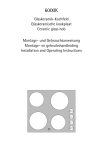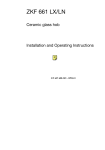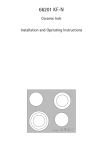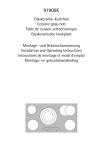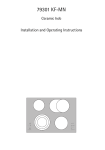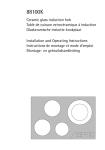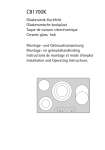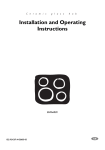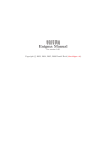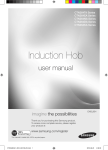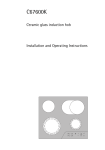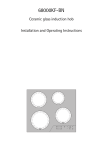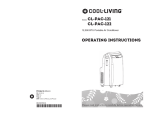Download C66301K-MN User manual - Eurohome Kitchens and Appliances
Transcript
66301K-mn Ceramic glass hob Table de cuisson vetrocéramique Glaskeramische kookplaat Installation and Operating Instructions Instructions de montage et mode d’emploi Montage- en gebruikshandleiding Dear customer, Please read these operating instructions carefully. Pay particular attention to the section “Safety information” on the first few pages. Please retain these operating instructions for later reference. Pass them on to possible new owners of the appliance. 1 3 2 The following symbols are used in the text: Safety instructions Warning: Information concerning your personal safety. Important: Information on how to avoid damaging the appliance. Information and practical tips Environmental information 1. These numbers indicate step by step how to use the appliance. 2. … 3. … These operating instructions contain information on steps you can take yourself to rectify a possible malfunction. Refer to the section “What to do if...”. In the event of any technical problems please contact your nearest customer service centre at any time. (Addresses and telephone numbers may be found in the appendix under "Customer Service Centres“). You should also refer to the section "Service". Printed on recycled paper. Thinking ecologically means acting ecologically … 2 Contents Operating Instructions . . . . . . . . . . . . . . . . . . . . . . . . . . . . . . . . . . . . . 5 Safety . . . . . . . . . . . . . . . . . . . . . . . . . . . . . . . . . . . . . . . . . . . . . . . . . . . . . . . . . 5 Disposal . . . . . . . . . . . . . . . . . . . . . . . . . . . . . . . . . . . . . . . . . . . . . . . . . . . . . . . 7 The Key Features of Your Appliance . . . . . . . . . . . . . . . . . . . . . . . . . . . . . . 8 Description of the Appliance . . . . . . . . . . . . . . . . . . . . . . . . . . . . . . . . . . . . . 9 Cooking zones and control panel. . . . . . . . . . . . . . . . . . . . . . . . . . . . . . . . . . . 9 Digital displays . . . . . . . . . . . . . . . . . . . . . . . . . . . . . . . . . . . . . . . . . . . . . . . . . . 10 Safety cut-out function for the cooking zones . . . . . . . . . . . . . . . . . . . . . . . 10 Before Using for the First Time. . . . . . . . . . . . . . . . . . . . . . . . . . . . . . . . . . . 11 Initial Cleaning. . . . . . . . . . . . . . . . . . . . . . . . . . . . . . . . . . . . . . . . . . . . . . . . . . 11 Operating the Hob . . . . . . . . . . . . . . . . . . . . . . . . . . . . . . . . . . . . . . . . . . . . . . Touch control sensor panels . . . . . . . . . . . . . . . . . . . . . . . . . . . . . . . . . . . . . . . Switching on the appliance . . . . . . . . . . . . . . . . . . . . . . . . . . . . . . . . . . . . . . . Switching off the appliance . . . . . . . . . . . . . . . . . . . . . . . . . . . . . . . . . . . . . . . Selecting cooking settings . . . . . . . . . . . . . . . . . . . . . . . . . . . . . . . . . . . . . . . . Keep warm setting. . . . . . . . . . . . . . . . . . . . . . . . . . . . . . . . . . . . . . . . . . . . . . . Switching the browning zone on and off . . . . . . . . . . . . . . . . . . . . . . . . . . . . Switching the triple ring zone on and off . . . . . . . . . . . . . . . . . . . . . . . . . . . STOP+GO function. . . . . . . . . . . . . . . . . . . . . . . . . . . . . . . . . . . . . . . . . . . . . . . Switching off a cooking zone. . . . . . . . . . . . . . . . . . . . . . . . . . . . . . . . . . . . . . Residual Heat Indicator . . . . . . . . . . . . . . . . . . . . . . . . . . . . . . . . . . . . . . . . . . . Cooking using the automatic warm up function . . . . . . . . . . . . . . . . . . . . . . Cooking without the automatic warm up function. . . . . . . . . . . . . . . . . . . . Child safety lock. . . . . . . . . . . . . . . . . . . . . . . . . . . . . . . . . . . . . . . . . . . . . . . . . Timer . . . . . . . . . . . . . . . . . . . . . . . . . . . . . . . . . . . . . . . . . . . . . . . . . . . . . . . . . . 11 11 11 12 12 13 13 14 15 16 16 17 18 19 22 Uses, Tables and Tips . . . . . . . . . . . . . . . . . . . . . . . . . . . . . . . . . . . . . . . . . . . . 25 Pans . . . . . . . . . . . . . . . . . . . . . . . . . . . . . . . . . . . . . . . . . . . . . . . . . . . . . . . . . . . 25 Advice on Cooking with and without Automatic Warm up . . . . . . . . . . . . . 26 Cleaning and Care . . . . . . . . . . . . . . . . . . . . . . . . . . . . . . . . . . . . . . . . . . . . . . 28 Hob . . . . . . . . . . . . . . . . . . . . . . . . . . . . . . . . . . . . . . . . . . . . . . . . . . . . . . . . . . . 28 Hob Frame . . . . . . . . . . . . . . . . . . . . . . . . . . . . . . . . . . . . . . . . . . . . . . . . . . . . . 29 What to do if … . . . . . . . . . . . . . . . . . . . . . . . . . . . . . . . . . . . . . . . . . . . . . . . . 30 Rectifying faults . . . . . . . . . . . . . . . . . . . . . . . . . . . . . . . . . . . . . . . . . . . . . . 30 3 Installation Instructions . . . . . . . . . . . . . . . . . . . . . . . . . . . . . . . . . . . Technical Data . . . . . . . . . . . . . . . . . . . . . . . . . . . . . . . . . . . . . . . . . . . . . . . . . . Regulations, Standards, Directives . . . . . . . . . . . . . . . . . . . . . . . . . . . . . . . . . . Safety Instructions for the Installer. . . . . . . . . . . . . . . . . . . . . . . . . . . . . . . . . Electrical Connection. . . . . . . . . . . . . . . . . . . . . . . . . . . . . . . . . . . . . . . . . . . . . Service . . . . . . . . . . . . . . . . . . . . . . . . . . . . . . . . . . . . . . . . . . . . . . . . . . . . . . 37 Assembly . . . . . . . . . . . . . . . . . . . . . . . . . . . . . . . . . . . . . . . . . . . . . . . . . . . . 4 32 32 33 34 35 114 Operating Instructions 1 Safety The safety aspects of this appliance comply with accepted technical standards and the German Appliance Safety Law. However, as manufacturers we also believe it is our responsibility to familiarise you with the following safety instructions. Electrical Safety 3 • The installation and connection of the new appliance must only be carried out by qualified personnel. • Repairs to the appliance are only to be carried out by approved service engineers. Repairs carried out by inexperienced persons may cause injury or serious malfunctioning. If your appliance needs repairing, please contact your local customer center or your dealer. Please follow these instructions, otherwise the warranty will not cover any damage that may occur. • Flush-mounted appliances may only be operated following installation in suitable installation cabinets and workplaces which conform to the relevant standards. This ensures sufficient protection against contact for electrical units as required by the VDE [Association of German Electrical Engineers]. • If your appliance malfunctions or if fractures, cracks or splits appear: – switch off all cooking zones, – disconnect the hob from the electricity supply. Child Safety The cooking zones will become hot when you cook. Therefore, always keep small children away from the appliance. Safety During Use • This appliance may only be used for normal cooking and frying in the home. It is not designed for commercial or industrial purposes. • Do not use the hob to heat the room. • Take care when plugging electric appliances into mains sockets near the hob. Connection leads must not come into contact with the hot surface. 5 • Overheated fats and oils catch fire quickly. You should supervise cooking when preparing foods in fat or oil (e.g. chips). • Switch off the cooking zones after use. Safety When Cleaning • For safety reasons do not clean the appliance with a steam jet or high pressure cleaner. • Clean the hob in accordance with the maintenance and cleaning instructions in this manual. To Avoid Damaging Your Appliance • Do not use the hob as a work surface or for storage. • Do not operate the cooking zones when there is no pan or the pans are empty. • Ceramic glass is insensitve to temperature shock and very robust; however it is not unbreakable. Especially sharp and hard objects that fall on the cooking surface can damage it. • Do not use cast iron pans or pans with a rough, burred or damaged base. Scratching may occur if the pans are slid across the surface. • Do not place any pans on the hob frame. Scratching and damage to the paint may occur. • Make sure that no acidic liquids, e.g. vinegar, lemon or descaling agents, are spilt onto the hob frame, since these cause dull spots. • If sugar or a preparation with sugar comes into contact with the hot cooking zone and melts there it must be cleaned off immediately with a scraper while it is still hot. If it cools, the surface may be damaged when it is removed. • Keep all items and materials that can melt away from the ceramic glass surface, e.g. plastics, aluminium foil, or oven foils. If something of this nature should melt onto the ceramic glass surface, it must also be removed immediately using the scraper. 6 2 Disposal Disposing of the packaging material All materials used can be fully recycled. Plastics are marked as follows: • >PE< for polyethylene, as used for the outer wrapping and the bags inside. • >PS< for polystyrene foam, e.g., as used for the padding materials. They are completely free of CFCs. Disposal of old appliances 1 Warning: Before disposing of old appliances please make them inoperable so that they cannot be the source of danger. To do this, disconnect the appliance from the mains supply and remove the mains lead. To protect the environment, it is important that worn out appliances are disposed of in the correct manner. • The appliance must not be disposed of with household rubbish. • You can obtain information about collection dates or public refuse disposal sites from your local refuse department or council. 7 The Key Features of Your Appliance • Ceramic glass cooking surface: The appliance has a ceramic glass cooking surface and 4 rapid response cooking zones. The particularly powerful radiant heater elements significantly shorten the amount of time taken for the zones to heat up. • Sensor fields: Your appliance is operated using Touch Control sensor fields. • Cleaning: The advantage of the ceramic glass cooking surface and the sensor fields is their accessibility for cleaning. The smooth, flat surface is easy to clean. • On/Off sensor field: The “On/Off” sensor field provides the appliance with a separate mains switch. Touching this switches the power supply on or off completely. • Control and function indicators: Digital indicators or control lamp provide information about settings made, functions activated, as well as any residual heat of the corresponding cooking zone. • Safety cut-out: A safety cut-out ensures that all cooking zones switch off automatically after a period of time if the setting has not been changed. • Keep Warm: u this setting is used for keeping food warm. • Stop+Go sensor field: Touching this sensor field changes all cooking zones currently in use to the ”keep warm“ function: touching the field again restores the zones to their former settings. This function can be useful in certain situations, for example if you are suddenly called away from the cooker. • Residual heat indicator: An h for residual heat is shown in the display if the cooking zone becomes so hot that there is a risk of burning. • Multipurpose cooking zone: The hob is equipped with a multipurpose/casserole cooking zone. Depending on the setting, it can be used as a round or oval cooking zone, e.g. for oval casseroles or for keeping dishes or food warm. • Triple ring cooking zone: The hob features a triple-ring cooking zone. This zone can be set to different sizes, for example to fit smaller pots. This will save power. • Timer: All zones can be automatically switched off using the integrated timer. When the end of the cooking time has been reached, the cooking zone switches off. 8 Description of the Appliance Cooking zones and control panel Single ring cooking zone 1200W Triple ring cooking zone 2300W Casserole zone 2400W Control panel Three-ring sensor panel Sensor panel Three-ring control lamps ”Stop+Go” Sensor panel ”On/Off” Single ring cooking zone 1200W Browning zone sensor panel Browning zone control lamp Cooking setting se“Timer” with Cooking setting selector lector control indicators Indicator for cooking setting/ residual warmth 9 Digital displays The four display panels that belong to the four cooking zones indicate: – ¾ after having been switched on, – u when a keep warm setting has been selected, – ¿ to Ç, depending on the cooking setting selected, – 2 to 6 (with decimal point) for intermediate cooking settings, – a when the automatic warm up function is in operation, – h when there is residual warmth, – l when the child safety device has been switched on, – e when there is a malfunction 1 Safety cut-out function for the cooking zones If one of the cooking zones is not switched off after a certain period of time or the cooking setting is not altered, that particular cooking zone will automatically switch itself off. Any residual warmth will be indicated with h (as for “hot”) in the digital displays corresponding to the particular cooking zones. The cooking zones switch themselves off when: • Cooking setting u, 1 - 2 after 6 hours • Cooking setting 3-4 after 5 hours • Cooking setting 5 after 4 hours • Cooking setting 6-9 after 1.5 hours 3 Should one or more cooking zones switch themselves off before the periods of time indicated have elapsed, see the chapter “What to do if …”. Other causes for a cooking zone switching itself off All cooking zones will immediately switch themselves off if liquid boils over and lands on the control panel. The same thing will happen if you place a damp cloth on the control panel. In both instances, after the liquid or cloth has been removed, the appliance will need to be switched on again using the main switch I. 10 Before Using for the First Time Initial Cleaning 1 Wipe the ceramic glass surface with a damp cloth. Important: Do not use any caustic, abrasive cleaners! The surface could be damaged. Operating the Hob Touch control sensor panels 3 To operate the touch control sensor panels, touch the desired panel with the tip of your pointed finger until the relevant displays illuminate or go out, or until the desired function is carried out. Ensure that you are only touching one sensor panel when operating the appliance. If you finger is too flat on the panel, the sensor panel below may be actuated as well. Switching on the appliance The entire appliance is switched on using the ”On/Off” sensor panel I. Touch the “On/Off” sensor panel for approx. two seconds. 3 The digital displays will show ¾. After the “On/Off” sensor panel has been actuated to switch on your appliance, a cooking setting must be selected for a cooking zone within approx. 10 seconds, or a time must be set using the timer (egg timer function). If not, the appliance will switch itself off again for reasons related to safety. 11 Switching off the appliance To completely switch off the appliance, actuate the “On/Off” sensor panel I. Touch the “On/Off” sensor panel for approx. one second. 3 After switching off a single cooking zone or the entire cooking surface, the existing residual warmth will be displayed in the digital displays of the corresponding cooking zones in the form of h (for “hot”). Selecting cooking settings For setting and changing the cooking setting (u to Ç) for the selected cooking zone. Raise the cooking setting using the cooking setting selector sensor panel . Lower the cooking setting using the cooking setting selector sensor panel . 12 Keep warm setting Each of the 4 cooking zones has a keep warm setting u. Use the cooking setting selector sensor panel to set the keep warm setting u. Switching the browning zone on and off 1. Set the desired cooking setting. 2. To switch the browning zone on or off, place your finger flat on the “browning zone” sensor panel until the indicator light illuminates or goes off. 13 Switching the triple ring zone on and off 3 According to the size of the saucepan or frying pan, when using the triple ring cooking zone you can switch from a smaller cooking zone to a larger cooking zone using the “triple ring zone” sensor panel. You can only switch to the next size if a cooking setting has already been set for the smaller heating ring. 1. Set the desired cooking setting. 2. Touch the “triple ring” sensor panel. This will switch the setting to the centre heating ring. The lower control lamp will illuminate. 14 3. Touch the “triple ring” sensor panel to activate the outer heating ring. The upper control lamp will illuminate. 4. To switch off the outer heating ring, touch the “triple ring” sensor panel, and the heating ring that is outermost at the time will switch off. STOP+GO function When the “Stop+Go” sensor panel is actuated all cooking zones that are switched on are simultaneously switched to the keep warm setting. The control light for the “Stop+Go” sensor panel will illuminate. The keep warm setting will be indicated in the display with u. 3 When the “Stop+Go” sensor panel is actuated again, the cooking settings that were previously selected are reset and the control light goes out. The timer is not stopped by the Stop+Go function. If an automatic warm up function was selected in the heating up stage a this will be stopped by the Stop+Go function, and the previously selected cooking setting will be reset by actuating the “Stop+Go” sensor panel again. 15 Switching off a cooking zone 1. To switch off a cooking zone touch the cooking setting selector sensor panel and simultaneously, or return the setting to zero using the cooking setting selector sensor panel . Residual Heat Indicator 2 1 1 16 When an individual cooking zone or the entire hob is switched off, any residual heat is shown with an h (for “Hot”) in the digital display for the appropriate cooking zones. Even after the cooking zone has been switched off, the residual heat indicator only goes out when the cooking zone is cold. You can use the residual heat for melting and keeping food warm. Important! As long as the residual heat indicator is illuminated, there is a risk of burns. Important! If the power supply is interrupted the h symbol will also go out and information about residual heat will no longer be available. However, it may still be possible to burn yourself. This can be avoided by taking care when near the hob. Cooking using the automatic warm up function All of the cooking surface’s four cooking zones can be adjusted to any of nine settings, and are equipped with an automatic warm up function: – ¿, lowest cooking setting – Ç, highest cooking setting – a, automatic warm up function. When you select the desired cooking setting using the cooking setting selector sensor panel, the cooking zone will operate at maximum power for a certain period of time and will then automatically switch back to the follow-on cooking setting that has been set. The length of time that the automatic warm up function operates depends on the follow-on cooking setting selected. 1. Touch the cooking setting selector sensor panel to set the desired cooking setting from ¿ to Æ. The cooking setting that has been set will then be displayed. After a period of 5 seconds, the a (=automatic warm up function) will appear in the display in place of the cooking setting. After the warm up period has finished, the cooking setting will once more be displayed. 3 If you should choose a higher heat setting while the automatic function is in operation, e.g. from Á to Ã, the period of time that the warm up function is in operation will be adjusted accordingly. If you select a lower setting, the warm up period will end immediately. You can cook using the automatic warm up function only if the cooking zone is cold or moderately warm. If a cooking zone is already hot when you switch it on (h indicator), the automatic warm up function cannot be used. 17 Cooking without the automatic warm up function If you wish to use the cooking zones without the automatic warm up function, select the desired cooking setting using the cooking setting selector sensor panel . 1. Touch the cooking setting selector sensor panel in order to set the desired cooking setting from Ç to ¿. 3 18 You can change the setting at any time using the cooking setting selector sensor panels and . Child safety lock You can use the child safety lock to safeguard against unwanted use of the cooking surface. Switching on the child safety lock To be able to switch on the child safety lock the appliance must be switched on, but all the cooking zones must be switched off. 1. Touch the sensor field for approx. three seconds. An acoustic signal will sound as confirmation. 2. Touch any heat setting sensor field . l will appear in the displays, and the child safety lock is activated. The appliance will switch itself off automatically after a few seconds. 19 Overriding the child safety lock The child safety lock can be overridden in order to use the appliance (until the appliance is switched off again). When the appliance is switched on again the child safety device is activated once again. 1. Switch on the appliance. When the child safety device has been activated, l will be displayed. 2. Touch any two heat setting sensor fields and simultaneously. An acoustic signal will sound as confirmation. The child safety device has been overridden until the appliance is switched off, and the cooking surface can be used as normal. 20 Switching off the child safety lock 1. Switch on the appliance. When the child safety device has been activated, l will be displayed. 2. Touch the sensor field for approx. three seconds. An acoustic signal will sound as confirmation. 3. Touch any heat setting sensor field . The displays will become dark, and the child safety device is switched off. The appliance will switch itself off automatically after a few seconds. 21 Timer 3 There are two ways to use the timer: – as a safety cut-out function. Set a cooking period for a cooking zone, and after this time has elapsed the cooking zone will automatically switch itself off. This function can be used for more than one cooking zone simultaneously. – as a countdown timer without a cut-out function (“egg timer”), whereby an acoustic signal can be heard after the set period of time has elapsed. The countdown timer cannot be used if a cooking zone is switched on. Safety cut-out The cooking zone(s) for which you want to use the safety cut-out function must be switched on. 1. Using the timer sensor panel, select the cooking zone for which the safety cut-out is to be set. By touching the timer sensor panel once the first active cooking zone is selected in a clockwise direction, and the corresponding control lamp will flash rapidly. Hereby the (e.g.) left rear control lamp corresponds to the left rear cooking zone. 00 will appear in the timer display. The next active cooking zone is selected by touching the timer sensor panel again. 22 2. While the control lamp is flashing rapidly, use the or timersetting sensor panels to set the desired period of time for this cooking zone up until the point where it automatically switches itself off (e.g. 15 minutes). The safety cut-out function will be activated after several minutes The control lamp will now flash more slowly and the remaining cooking time will be shown in the display as it elapses. If the safety cut-out function has been set for more than one cooking zone, the time displayed will be that for the cooking zone with the shortest period of cooking time remaining. The control lamps for the other cooking zones for which the safety cut-out function has been set will illuminate. To display the remaining cooking time for any of these cooking zones, it must be selected using the timer sensor panel, and the corresponding control lamp will then flash rapidly. To reset the remaining cooking time the desired cooking zone must be selected using the timer sensor panel. The corresponding control lamp will then flash more rapidly. The settings are reset using the or timer setting sensor panels. 3 After the set period of cooking time has elapsed the cooking zone automatically switches itself off, an acoustic signal sounds for two minutes and the timer display flashes 00. 3. To switch off the signal, touch the timer sensor panel. To make the setting more quickly, touch any of the or timer setting sensor panels until the desired value is reached. If the timer setting sensor panel is actuated first, the time setting will begin at 99 minutes, and if the timer setting sensor panel is actuated first, the time setting will begin at 1 minute. 23 Switching off the safety cut-out function before it has come to an end There are two ways to switch off the safety cut-out function before it has come to an end. Switch off the cooking zone and timer simultaneously 1. Using the cooking setting selector sensor panel, reset the desired cooking zone to zero: the cooking zone and timer will switch themselves off. Switch off the timer – the cooking zone remains active 1. Select the desired cooking zone using the timer sensor panel. The corresponding control lamp will then flash more rapidly. 2. Using the timer setting sensor panel, set the timer to 00: – only the timer will switch itself off. – the cooking zone will remain in operation. Countdown timer To be able to use the countdown timer the appliance must be switched on, but all the cooking zones must be switched off. 1. Touch the timer sensor panel. 00 will be shown in the timer display. 2. Set the desired period of time using the or timer setting sensor panels. The countdown timer function will be activated after several minutes and the remaining time will be displayed. To reset the remaining time, touch the timer sensor panel and change the setting using the or sensor panels for setting the timer. After the set period of time has elapsed an acoustic signal sounds and the timer display flashes 00. 3. To switch off the signal, touch the timer sensor panel. 24 Uses, Tables and Tips Pans The better the pan, the better the results. • You can recognise good pans by their bases. The base should be as thick and flat as possible. • Pay particular attention when buying new pans to the diameter of the base. Manufacturers often give only the diameter of the upper rim. • Pots with aluminium or copper bases can cause metallic discolouring on the glass ceramic surface, which is very difficult or impossible to remove. • Do not use cast iron pans or pans with a rough, burred or damaged base. This can produce permanent scratching if the pan is slid across the surface. • When cold, pan bases are normally bowed slightly inwards (concave). They should never be bowed outwards (convex). • If you wish to use special types of pan (e.g. a pressure cooker, simmering pan, wok, etc.), please observe the manufacturer's instructions. 2 Energy saving tips You can save valuable energy by observing the following points: • Always position pots and pans before switching on the cooking zone. • Dirty cooking zones and pan bases increase power consumption. • Whenever possible always position the lids firmly on pots and pans to cover completely. • Switch off the cooking zones before the end of the cooking time to use the residual heat such as to keep foods warm or for melting. 25 • The base of the pan should be the same size as the cooking zone. • Using a pressure cooker reduces cooking times by up to 50%. Advice on Cooking with and without Automatic Warm up The automatic warm up function is suitable for: • dishes that start off cold, are heated up at high power and do not need to be continually watched when cooking on the selected heat setting, • dishes that are put in a hot frying pan. The automatic warm up function is not suitable for: • goulash, beef olives and similar braised dishes that need continual turning until browned correctly, have liquid added and are then braised until cooked, • dumplings, pasta dishes with large amounts of liquid, • cooking with pressure cookers, • very large quantities of soup/stew with more than 2 litres of liquid. General notes: • When cooking without the automatic warm up function, we recommend the use of a high heat setting to warm up the food (using the button) and then leave the dish to finish cooking at an appropriate lower heat setting. • Take special note of the results when you first use the appliance! You can then decide which heat setting is the best for "your dishes" in the "quantities you are accustomed to preparing" with "your pans". You will then quickly appreciate the advantages of the automatic function and will feel relaxed about using your new hob. 26 Reference values for your cooking The figures in the following table are benchmark figures. The switch setting required for a certain cooking method depends on the quality of the pans and the type and amount of food. Switch setting Automatic warm up function1) (min.) 9 8 Cooking method Examples for use Warming Sautéing Frying Warming large amounts of liquid, boiling noodles, searing meat, (browning goulash, braising meat) Steak, sirloin, hash browns, sausages, pancakes/griddle cakes 4,5 7 3,5 Intensive frying 6 2,0 Frying Schnitzel/chops, liver, fish, rissoles, fried eggs 5 10,2 4 6,5 Boiling Cooking up to 1.5 l liquid, potatoes, vegetables 3 4,8 2 1,7 Steaming Stewing Boiling Steaming and stewing of small amounts of vegetables, boiling rice and milk dishes 1 1,0 Melting Melting butter, dissolving gelatine, melting chocolate u 0,5 Keeping warm Keeping meals warm 1) When cooking without the automatic function the warm up period can be individually selected. 3 3 When warming or sautéing food we recommend that you set the appliance to warm up setting “9” and then, for food which requires a longer cooking time, switch to the appropriate follow on cooking setting to finish cooking the food. 27 Cleaning and Care Hob 1 3 Important: Cleaning agents must not come into contact with the hot ceramic glass surface! All cleaning agents must be removed with plenty of clean water after cleaning because they can have a caustic effect when the rings are next heated! Do not use any aggressive cleaners such as grill or oven sprays, coarse scourers or abrasive pan cleaners. Clean the ceramic glass surface after each use when it is warm to the touch or cold. This will avoid spillages becoming burnt on. Remove scale and water marks, fat spots and discolouration with a metallic shimmer using a commercially available ceramic glass or stainless steel cleaner. Light Soiling 1. Wipe the ceramic glass surface with a damp cloth and a little washing up liquid. 2. Then rub dry with a clean cloth. Remnants of cleaner must not be left on the surface. 3. Thoroughly clean the entire ceramic glass cooking surface once a week with a commercially available ceramic glass or stainless steel cleaner. 4. Then wipe the ceramic glass surface using plenty of clean water and rub dry with a clean fluff-free cloth. Stubborn Soiling 3 28 1. To remove food that has boiled over or stubborn splashes, use a glass scraper. 2. Place the glass scraper at an angle to the ceramic glass surface. 3. Remove soiling by sliding the blade. You can obtain glass scrapers and ceramic glass cleaners from specialist retailers. 1 Problem Dirt 1. Remove burnt-on sugar, melted plastic, aluminium foil or other meltable materials with a glass scraper immediately and while still hot. 1 3 Important: There is a risk of burning yourself when the glass scraper is used on a hot cooking zone! 2. Then clean the hob normally when it has cooled down. If the cooking zone on which something has melted has already cooled down, warm it up again for cleaning. Scratches or dark marks on the ceramic glass surface, caused for example by a pan base with sharp edges, cannot be removed. However, they do not impair the function of the hob. Hob Frame 1 Important! Do not put vinegar, lemon-juice or scale removers on the hob frame, otherwise dull spots will appear. 1. Wipe the frame with a damp cloth and a little washing up liquid. 2. Soften dried dirt with a wet cloth. Then wipe off and rub dry. 29 What to do if … Rectifying faults 1 It is possible that faults have been caused by a minor error, which you can correct yourself with the help of the following instructions. Do not attempt any further repairs if the following instructions do not help in each specific case. Warning! Repairs to the appliance are only to be carried out by approved service engineers. Improperly effected repairs may result in considerable risk to the user. If your appliance needs repairing, please contact your specialist dealer or customer service. If the ceramic glass hob is broken, please quote the 3-digit number on the glass hob when contacting customer service. What to do if … … the cooking zones are not functioning. Check whether – the fuse in the house wiring (fuse box) is intact. If the fuses trip a number of times, please call an authorised electrician. – the appliance is properly switched on, – the control lamps in the control panel are illuminated, – the relevant cooking zone is switched on, – the cooking zones are set at the desired settings, – the cooking zones’ safety switchoff function has been activated (see “Safety” chapter). … you cannot switch on the cooking zones. Check whether – a period of more than 10 seconds has elapsed between when the On/ Off button was actuated and the desired cooking zone switches on (see chapter “Switching on the appliance”). – the sensor panels are partially covered by a damp cloth or liquid. … the display suddenly disappears except for h for residual warmth. Check whether – the On/Off button was accidentally actuated. – the sensor panels are partially covered by a damp cloth, liquid or similar. – the safety switchoff function has been activated. 30 … after having switched off the cooking zones, no h for residual warmth is indicated in the display. Check whether – the cooking zone was only briefly used and therefore did not become hot enough. If the cooking zone is hot, please call customer service. … a cooking zone will not switch off. Check whether – the sensor switches are partially covered by a damp cloth or liquid. – the Stop+Go function is switched on. …a cooking zone will not switch on. Check whether – the child safety device is swiched on. – the Stop+Go function is switched on. … the e display is illuminated? Check whether the cooking zone has been overheated. This display illuminates in the event of overheating, errors in the electronic equipment or for reasons related to safety. … the appliance is not responding when a sensor panel is actuated. The appliance will not respond to a sensor panel being actuated if you are simultaneously touching another sensor panel that is not part of a combination. If you request a visit from customer service because of an error made in operating the appliance, a visit from a customer service engineer may not be free of charge even during the warranty period. 31 Installation Instructions 1 Important! The new appliance may only be installed and connected by qualified personnel. Please observe this instruction, otherwise the warranty will not cover any damage that may occur. Technical Data Appliance dimensions Width Depth Height 572 mm 502 mm 47 mm Worktop cut-out dimensions Width Depth Corner radius 560 mm 490 mm R5 Cooking rings Position Front left Rear left Rear right Front right Diameter 120/175/210mm 145mm 170/265mm 145mm Connection voltage Maximum connected load power 32 Power 800/1600/2300W 1200W 1500/2400W 1200W 230 V ~ 50Hz 7,1kW Regulations, Standards, Directives This appliance meets the following standards: • EN 60 335-1 and EN 60 335-2-6 relating to the safety of electrical appliances for household use and similar purposes and • EN 60350, or DIN 44546 / 44547 / 44548 relating to the operating features of electric cookers, hobs, ovens, and grills for household use. • EN 55014-2 • EN 55014 • EN 61000-3-2 • EN 61000-3-3 • relating to basic requirements for electro-magnetic compatibility protection (EMC). 5 This appliance complies with the following EU Directives: • 73/23/EWG dated 19.02.1973 (Low Voltage Directive) • 89/336/EWG dated 03.05.1989 (EMC Directive including Amending Directive 92/31/EWG). 33 1 Safety Instructions for the Installer • A device must be provided in the electrical installation which allows the appliance to be disconnected from the mains at all poles with a contact opening width of at least 3 mm. Suitable isolation devices include line protecting cut-outs, fuses (screw type fuses are to be removed from the holder), earth leakage trips and contactors. • In respect of fire protection, this appliance corresponds to EN 60 335-2-6. This type of appliance may be installed with a high cupboard or wall on one side. • Drawers may not be fitted underneath the hob. • The installation must guarantee shock protection. • The kitchen unit in which the appliance is fitted must satisfy the stability requirements of DIN 68930. • For protection against moisture, all cut surfaces are to be sealed with a suitable sealant. • On tiled work surfaces, the joints in the area where the hob sits must be completely filled with grout. • On natural, artificial stone, or ceramic tops, the snap action springs must be bonded in place with a suitable artificial resin or mixed adhesive. • Ensure that the seal is correctly seated against the work surface without any gaps. Additional silicon sealant must not be applied; this would make removal more difficult when servicing. • The hob must be pressed out from below when removed. 34 Electrical Connection 1 Before connecting, check that the nominal voltage of the appliance, that is the voltage stated on the rating plate, corresponds to the available supply voltage. The rating plate is located on the lower casing of the hob. The heating element voltage is AC230V~. The appliance also works perfectly on older networks with AC220V~. The hob is to be connected to the mains using a device that allows the appliance to be disconnected from the mains at all poles with a contact opening width of at least 3 mm, eg. automatic line protecting cutout,earth leakage tripsorfuse. A type H05VV-F cable or one with a higher grade must be used as the mains connecting cable. The connection must be carried out as shown in the diagram. The connecting links should be fitted according to the appropriate connection diagram. The earth lead is connected to terminal E. The earth lead must be longer than leads carrying electric current. The cable connections must be made in accordance with regulations and the terminal screws tightened securely. Finally, the connecting cable is to be secured with the mains cable cleat and the covering closed by pressing firmly (lock into place). Before switching on for the first time, any protective foil or stickers must be removed from the glass ceramic surface. Once connected to the mains supply check that all cooking zones are ready for use by briefly switching each on in turn at the maximum setting. 35 36 Service In the “What to do if …” section a number of malfunctions are listed that you can rectify yourself Look there first if a fault occurs. Is it a technical fault? If so, please contact your customer service centre. (You will find addresses and telephone numbers in the section “Customer Service Centres”.) Always prepare in advance for the discussion. This will make diagnosis of the problem easier and also make it easier to decide if a customer service visit is necessary: Please make a note of the following information as accurately as possible: • What form does the fault take? • Under what circumstances does the fault occur? Prior to the telephone call it is important that you make a note of the following appliance code numbers that are given on the rating plate: • model description, • PNC code (9 digits), • S No code (8 digits). We recommend that you record the code numbers here so that you always have them to hand: Model: . . . . . . . . . . . PNC: . . . . . . . . . . . S-No: . . . . . . . . . . . When do you incur costs even during the warranty period? • if you could have remedied the fault yourself using the fault table (see section “What to do if …”), • if the customer service technician has to make several journeys because he was not provided with all the relevant information before his visit and therefore, forexample, has to fetch spare parts. These multiple trips can be avoided if you prepare your phone call as described above. 37 Assembly / Montage 114 115 From the Electrolux Group. The world´s No.1 choice. The Electrolux Group is the world´s largest producer of powered appliances for kitchen, cleaning and outdoor use. More than 55 million Electrolux Group products (such as refrigerators, cookers, washing machines, vacuum cleaners, chain saws and lawn mowers) are sold each year to a value of approx. USD 14 billion in more than 150 countries around the world. Hier Typenschild aufkleben (nur für Werk) AEG Hausgeräte GmbH Postfach 1036 D-90327 Nürnberg http://www.aeg.hausgeraete.de © Copyright by AEG 822 924 127-A-230103-01 Subject to change without notice Sous réserve de modifications Wijzigingen voorbehouden








































